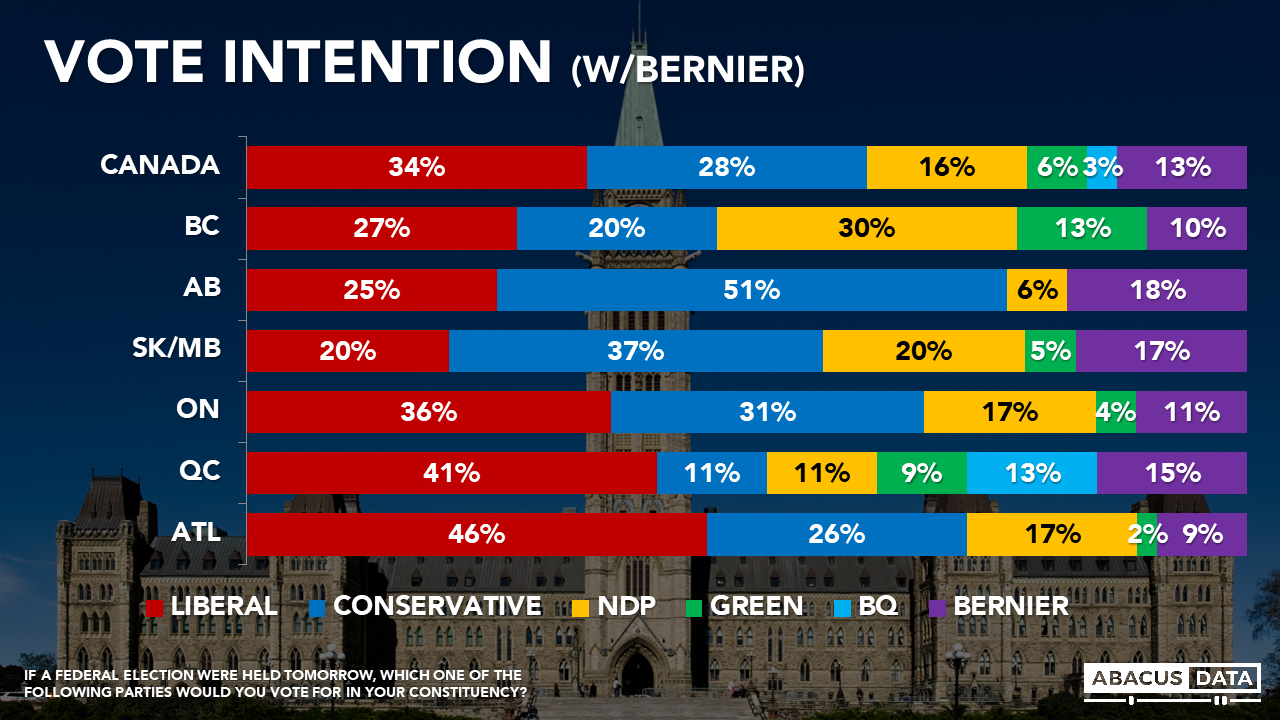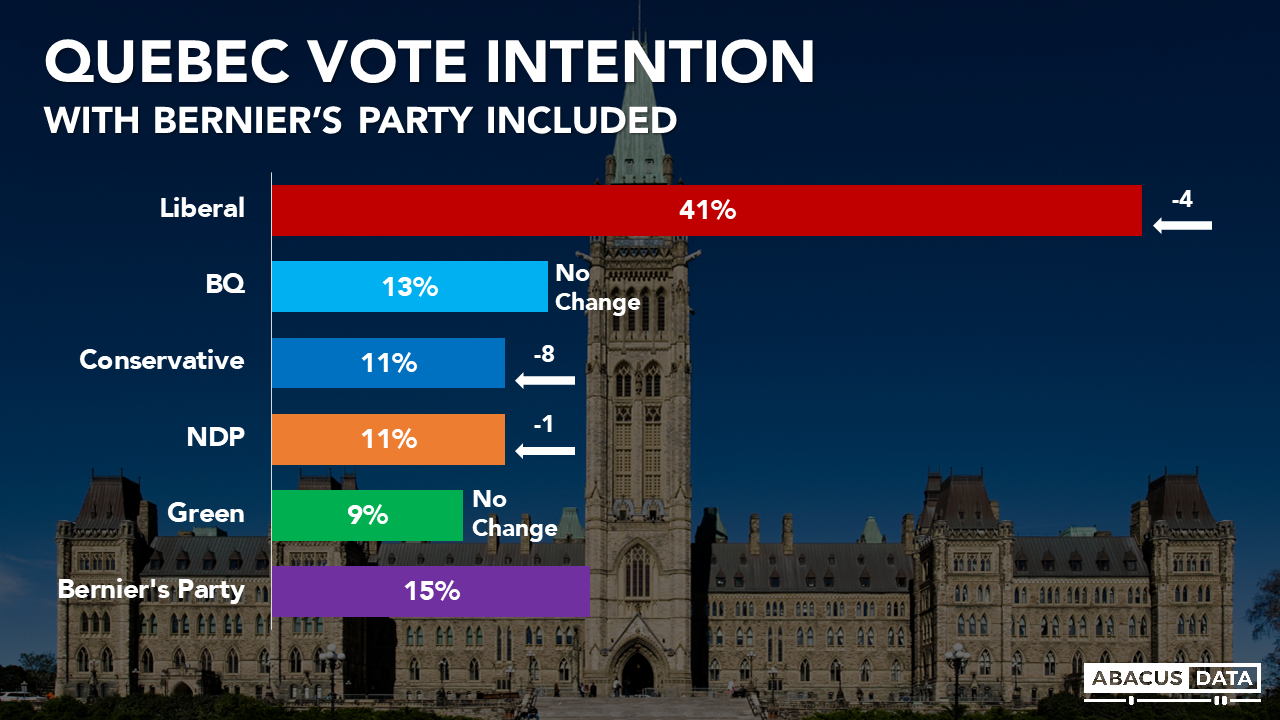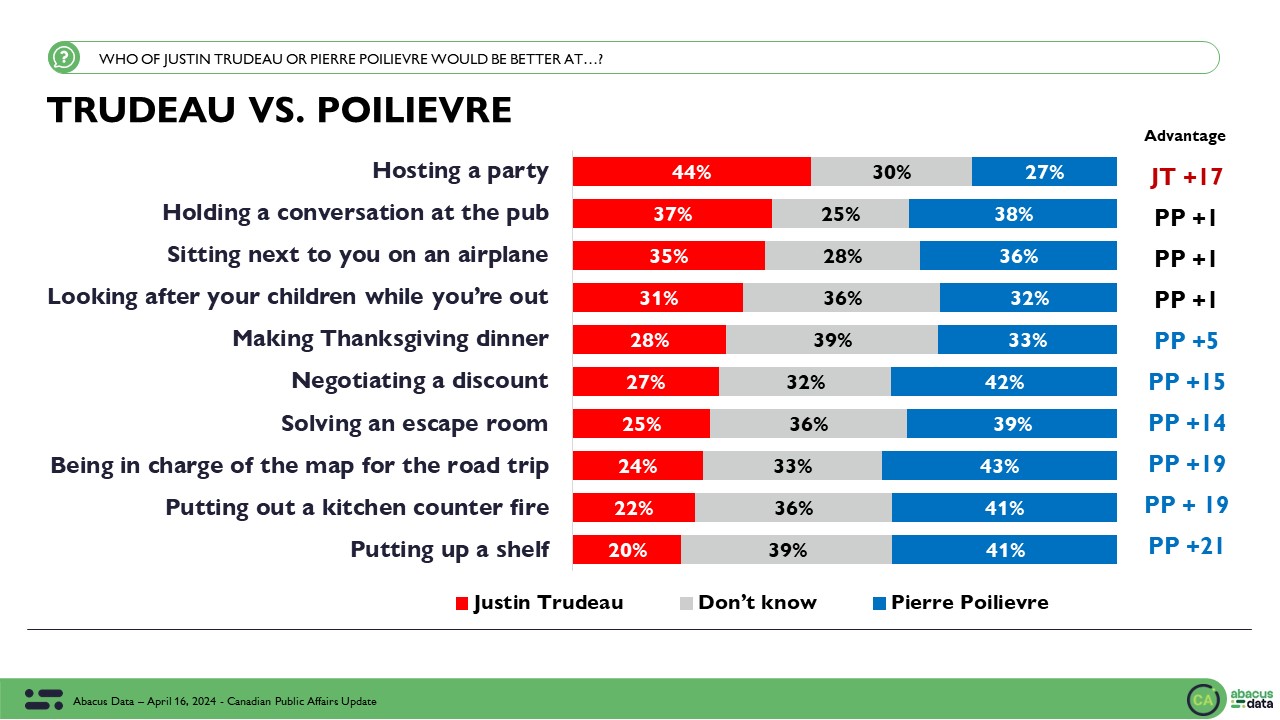Will Max Bernier be a spoiler for the Conservative Party?
August 26, 2018
It’s too early to know how Max Bernier’s full-blown attack on the Conservative Party of Canada will play out, but in our latest polling, we explored how people react to his arguments about that party and his decision to launch a new party based on some key policies.
Readers should bear in mind that all we can do at this point is measure the potential impact if Mr. Bernier were able to organize a slate of candidates and make his arguments heard – neither of which is a given.
With those caveats, here’s what we find:
Before introducing the subject of Mr. Bernier’s announcement, we measured voting intention and found them almost identical to the wave of research we released on Friday. The Liberals have a modest lead with 37% of the vote, followed by the Conservatives at 33% and the NDP at 18%.


After describing Mr. Bernier’s criticism of the Conservatives and informing respondents about his intention to form a new party which would reduce immigration, end supply management and avoids retaliatory tariffs against the US, we asked voting intentions again.
In an election with such a Bernier Party on offer, the Liberal lead would widen from 4 to 6 points nationally, but with potentially more significant impacts on a regional basis. Thirteen percent say they would vote for this Bernier Party with half of them coming from the Conservative Party support today.

Bernier could pull votes from all demographic groups but more so among men, and younger voters. Crucially, here are some impacts on a regional basis:

BC: Bernier could win 10% support, drawing both from the Liberals who would drop to 27% and the Conservatives who would drop to 20%, leaving the NDP ahead with 30%.

Ontario: Bernier could win 11%, which would turn what is now a dead heat into a 5-point lead for the Liberals. The Liberals would hold 36%, the Conservatives 31% the NDP 17%.

Quebec: Bernier could win 15%, with the second largest vote total, heavily impacting the potential for the Conservatives. The Liberals would be looking at 41% support, followed by Bernier at 15%, the Bloc at 13% and the Conservatives and NDP tied at 11%.

We tested reactions to three of the arguments made by Mr. Bernier as to why he decided to leave the party. We asked respondents whether they agreed with those statements personally.
“The Conservative Party is too intellectually corrupt to be reformed”.
Across the country, 55% agree with that argument, as do 21% of current Conservative Party voters, and 22% of those who voted Conservative in 2015. Agreement is 55% in BC, 54% in Ontario and 60% in Quebec.

“The Conservative Party has abandoned conservatives – it does not represent them anymore and has nothing of substance to offer Canadians looking for a political alternative.”
Across the country, 54% agree with that argument, as do 29% of current Conservative Party voters, and 30% of those who voted Conservative in 2015. Agreement is 55% in BC, 59% in Ontario and 55% in Quebec.

“The whole strategy of the Conservative Party is to play identity politics, pander to various interest groups, and buy votes with promises, just like the Liberals”.
Across the country, 62% agree with that argument, as do 36% of current Conservative Party voters, and 40% of those who voted Conservative in 2015. Agreement is 59% in BC, 62% in Ontario and a striking 72% in Quebec.

Asked how they would react if Mr. Bernier formed a new political party “that would be opposed to retaliatory tariffs on the United States, eliminate Canada’s dairy and poultry supply management systems and reduce immigration levels, 6% say they would be certain to vote for that party another 10% likely to, and 33% say they might consider doing so.

Certain/likely Bernier voters range from a low of 12% in Atlantic Canada to a high of 20% in Quebec. Men are almost twice as likely to be in this group, and Bernier’s potential is higher among those under 45 than those above that age.
A total of 18% of current Conservative voters say they are certain or likely to vote for the Bernier Party as described, another 34% say would consider it, 22% say they are unlikely to. Just 22% say they are certain not to.

UPSHOT
Bearing in mind that we are measuring reaction to an idea on a drawing board, and there is no certainty that Mr. Bernier will be able to build and market a party with these messages coming through clearly, this poll is by nature speculative and should be read as such.
Having said that, the results show that a considerable minority of Conservative voters find Mr. Bernier and his message attractive and confirm that he has the potential to divide and weaken the prospects of the Conservative Party heading into the 2019 election. The most important impacts could be felt in Ontario and Quebec, where 199 of 338 seats are at stake. Seats the Conservatives might be considering potential gains could have a greater chance of falling into the Liberal column.
Given that 20% and 40% of current conservative voters agree to some extent with the views expressed by Mr. Bernier, Conservative Leader Andrew Scheer can ill afford to ignore this threat. However, if he puts too much emphasis on trying to assuage these sentiments, he risks alienating mainstream voters who do not find Mr. Bernier’s arguments appealing, and also drawing constant attention to the fact that there are divisions within his Party. Mr. Bernier may or may not turn out to be a spoiler in 2019, but he undoubtedly spoiled some of the narrative that Conservatives were hoping their Halifax Convention would deliver.
There is, of course, a good possibility that nothing will come of Mr. Bernier’s announcement, in terms of a new party being prepared to compete in the 2019 election in which case the only issue will be whether the criticisms he raised about the Conservative policies and leader remain as factors that will stall or reverse the Party’s recent gains.
Methodology
Our survey was conducted online with 1,000 Canadians aged 18 and over from August 24 to 25, 2018. A random sample of panelists was invited to complete the survey for a set of partner panels based on the Lucid exchange platform.
The margin of error for a comparable probability-based random sample of the same size is
+/- 3.1%, 19 times out of 20. The data were weighted according to census data to ensure that the sample matched Canada’s population according to age, gender, educational attainment, and region. Totals may not add up to 100 due to rounding.




